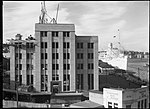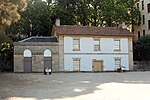1947 Sydney hailstorm

The 1947 Sydney hailstorm was a natural disaster which struck Sydney, Australia, on 1 January 1947. The storm cell developed on the morning of New Year's Day, a public holiday in Australia, over the Blue Mountains, hitting the city and dissipating east of Bondi in the mid-afternoon. At the time, it was the most severe storm to strike the city since recorded observations began in 1792.The high humidity, temperatures and weather patterns of Sydney increased the strength of the storm. The cost of damages from the storm were, at the time, approximately GB£750,000 (US$3 million); this is the equivalent of around A$45 million in modern figures. The supercell dropped hailstones larger than 8 centimetres (3.1 in) in diameter, with the most significant damage occurring in the central business district and eastern suburbs of Sydney.The event caused around 1000 injuries, with between 200 and 350 people requiring hospitalisation or other medical attention, predominantly caused by broken glass shards. The majority of severe injuries reported were suffered by people on Sydney's beaches, where many were without shelter. The size of the hailstones were the largest seen in Sydney for 52 years, until the 1999 Sydney hailstorm caused A$1.7 billion in insured damage in becoming the costliest natural disaster in Australian history.
Excerpt from the Wikipedia article 1947 Sydney hailstorm (License: CC BY-SA 3.0, Authors, Images).1947 Sydney hailstorm
Cahill Walk, Sydney Sydney
Geographical coordinates (GPS) Address Nearby Places Show on map
Geographical coordinates (GPS)
| Latitude | Longitude |
|---|---|
| N -33.859722222222 ° | E 151.21111111111 ° |
Address
Circular Quay Wharf 4
Cahill Walk
2000 Sydney, Sydney
New South Wales, Australia
Open on Google Maps










